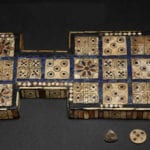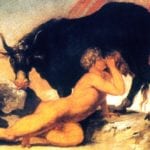 Weird Stuff
Weird Stuff  Weird Stuff
Weird Stuff  Our World
Our World 10 Ways Your Christmas Tree Is More Lit Than You Think
 Movies and TV
Movies and TV The 10 Coolest Stars to Set Sail on The Love Boat
 History
History 10 Things You Didn’t Know About the American National Anthem
 Technology
Technology Top 10 Everyday Tech Buzzwords That Hide a Darker Past
 Humans
Humans 10 Everyday Human Behaviors That Are Actually Survival Instincts
 Animals
Animals 10 Animals That Humiliated and Harmed Historical Leaders
 History
History 10 Most Influential Protests in Modern History
 Creepy
Creepy 10 More Representations of Death from Myth, Legend, and Folktale
 Technology
Technology 10 Scientific Breakthroughs of 2025 That’ll Change Everything
 Weird Stuff
Weird Stuff Ten Bizarre Facts About The Doge Meme
 Our World
Our World 10 Ways Your Christmas Tree Is More Lit Than You Think
 Movies and TV
Movies and TV The 10 Coolest Stars to Set Sail on The Love Boat
Who's Behind Listverse?

Jamie Frater
Head Editor
Jamie founded Listverse due to an insatiable desire to share fascinating, obscure, and bizarre facts. He has been a guest speaker on numerous national radio and television stations and is a five time published author.
More About Us History
History 10 Things You Didn’t Know About the American National Anthem
 Technology
Technology Top 10 Everyday Tech Buzzwords That Hide a Darker Past
 Humans
Humans 10 Everyday Human Behaviors That Are Actually Survival Instincts
 Animals
Animals 10 Animals That Humiliated and Harmed Historical Leaders
 History
History 10 Most Influential Protests in Modern History
 Creepy
Creepy 10 More Representations of Death from Myth, Legend, and Folktale
 Technology
Technology 10 Scientific Breakthroughs of 2025 That’ll Change Everything
10 Historical Drinking Games From Around The World
Social drinking has always been one of the most opportune times to do a bit of human bonding. To speed up the process, many resort to drinking games, which add an extra layer of competition to the proceedings in order to make them more fun. As it turns out, our ancestors did the same thing. Although drinking games have been around for thousands of years, today, we’re generally only familiar with beer pong and a few other recent inventions. However, history is here to provide you with inspiration for your next social outing.
10 The Wager Cup

Originally known as the jungfrauenbecher (“maiden’s cup”), this silver cup originated in 16th-century Germany and was predominantly used at weddings. The cup took the shape of a woman with a wide skirt that formed a cup when inverted. The woman also carried a pail or a bowl above her head which swiveled to remain upright, effectively creating two cups in one. During the wedding feast, the groom had to toast by drinking from the skirt cup without spilling any wine from the pivoting bowl, from which the bride then had to drink.
Eventually, the usage of the maiden or bridal cup made it to the Netherlands and England. By then, however, the cup had lost its connection with wedding toasts and was simply used for social activities. In England, the wager cup, as it was now known, became a popular drinking game. Participants had to drink all of the wine in the skirt cup without spilling any from the pail, and if they succeeded, they got to drink the pail wine, as well. The production of wager cups continued well into the 19th century. Even today, you can find modern replicas online, as well as expensive, original antiques.
9 Kottabos
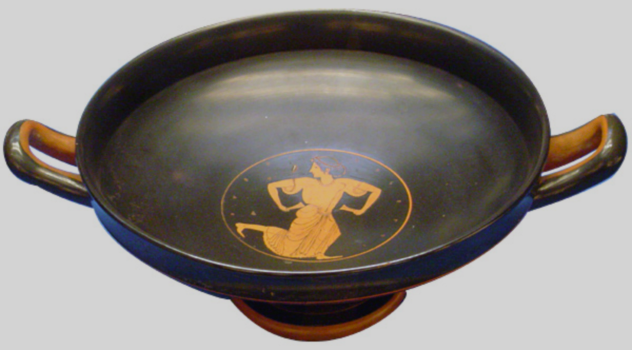
Kottabos was an ancient pastime developed in the fifth century BC and was popular at Greek symposiums (aka drinking parties). This kind of game probably wouldn’t be as successful today unless you had servants to clean up after you, as a typical game of kottabos left quite a mess. The game involved players drinking a lot of wine and throwing the dregs at various targets. Sometimes, the name of a loved one would be shouted during the throw.
The drinking cup used for kottabos was called a kylix. It had a wide but shallow body, more similar to a bowl, and handles on each side. The thrower would hold the kylix by one handle and use an overhand technique to cast the dregs. The kylix also featured an almost flat, circular center called a tondo. This area was often decorated with vulgar or humorous drawings that became more visible as the wine disappeared. One well-preserved example shows a man wiping his butt.
There were several variations on the rules of kottabos, but we know of two popular games from ancient art and texts. In one of them, the players had to knock off a disc balanced on a metal stand. In the other, there was a large bowl of water with dishes floating inside. The players had to throw enough dregs onto a dish in order to sink it.
8 Sumbel
Technically, sumbel was more of a drinking ritual than a game, but it featured heavily in Nordic tradition and was regarded as a good way to bond with those around you. There is a sumbel in Beowulf and in Heimskringla, the saga of Nordic kings. In essence, a sumbel is a social occasion where everyone would toast and take a drink before passing the cup to the next person. An authentic sumbel would feature mead drank from a horn. However, a cup was also acceptable, as were other drinks like wine or beer. The drinks had to be alcoholic, though.
It was important for each person to share a passionate toast before drinking. Thus, according to tradition, they would then swallow the words that they said. A typical format for a sumbel was three rounds preempted by a short introduction from the host. The first round was dedicated to the gods, and everybody who drank would hail and praise them. The second round was dedicated to heroes of old from history or legend, and the third was dedicated to personal ancestors or friends who had passed on. It was also possible to replace the toast with a poem, story, or song of personal significance.
7 Buffalo

Unlike all the other drinking games, Buffalo requires a serious commitment because, technically, you play it for the rest of your life. Once you agree to the Buffalo lifestyle, you become a member of the Buffalo Club. The American branch of the Buffalo Club has dozens of chapters in over 30 states, and many more have developed in Europe as well as Central and South America. For many, the biggest appeal of Buffalo is the feeling of belonging to a secret society, with fewer of the cloak-and-dagger aspects and more drinking.
As far as the game goes, Buffalo is fairly simplistic. Buffalo Club members must drink all alcoholic beverages with their nondominant hand. If they violate this rule, other members shout “buffalo,” and the offender has to chug their alcoholic beverage of choice. Although only other official members are allowed to take part, a true buffalo should not hesitate to “buffalo” himself if he is alone and breaks the code.
Although the origins of this game are blurry, and there are many stories out there, the most popular legend claims that Buffalo originated in the Wild West. Allegedly, gunslingers would prefer to do social activities like drinking and playing cards with their nondominant hand to keep their shooting hand free. If you want to become part of the Buffalo Club, be advised that only a current member is allowed to induct new ones.
6 Jiuling

Jiuling is a drinking game that has its origins sometime during China’s Zhou Dynasty between the 11th and 8th centuries BC. Although it started as a way of regulating people’s drinking, jiuling became a popular pastime on its own, and naturally, many variations of the concept arose.
Most types of jiuling were grouped into two categories—common and literary. Common jiuling was the most popular, since it was the most accessible to the masses. It was a simple game that involved each player taking a turn and then taking a drink. What exactly the players did during their turns varied wildly. They could tell a story or a joke or have some sort of contest where the loser would drink. Rolling dice and guessing fingers were popular contests.
Literary jiuling was more popular with the upper classes, as it required a higher education. This game was similar to the common version, but participants had to share riddles, poems, idioms, and so on. It was typically practiced by intellectuals who considered common jiuling to be vulgar.
5 Sconcing
Originally, “sconcing” was a term developed at Oxford University during the 17th century, referring to a fine levied against students for a misdemeanor. However, over the years, the students adopted the concept of sconcing themselves. Someone could be sconced for a breach of etiquette, but instead of a fine, the offender had to down a beer in one go. This was done at the challenger’s expense unless the offender couldn’t finish the drink, in which case he had to pay for it. Common offenses that were considered a breach of etiquette included topics such as religion, politics, and women.
There was a time when only the senior scholar at the table could impose a sconce. Other members could bring offenses to their attention only if they spoke in ancient Greek or Latin. Nowadays, sconcing is nowhere near as formal, and it’s more of a party game. Today, someone stands up and claims that they sconce anyone who has done a certain activity. Anyone to whom the sconce applies has to drink. If the sconce applies to no one, everyone else starts crying “shoe” until the wannabe sconcer takes off their footwear, fills it with beer, and chugs from it.
4 Pitch-Pot
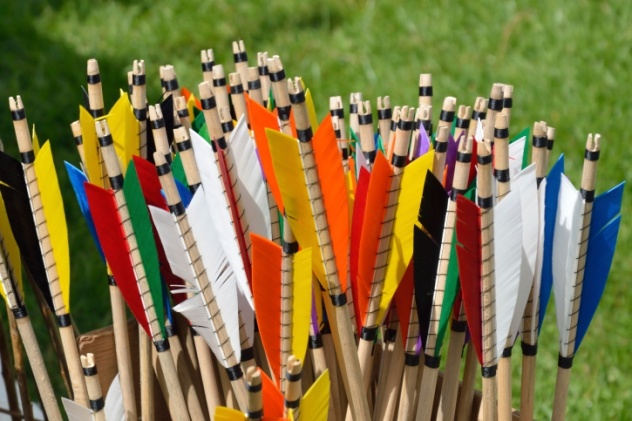
Pitch-pot, known as touhu in Chinese, originated in ancient China sometime during the Warring States period. It later spread to Japan, where it was known as toko, and Korea, where it was called tuho.
The basics of pitch-pot involve throwing arrows into a pot. Players stand a set distance away from the pot (typically the length of two and a half arrows) and take turns trying to throw the arrows straight into the pot. When a player scores a point (an entry), the victor presents the vanquished with a cup to drink. After the arrows are finished, both players kneel and the victor will once again refill the cup of the loser. If you want to stick to strict pitch-pot etiquette, it is also considered polite to refuse to play the first time you are offered the arrows, as well as the second. It’s okay to accept the third time.
We know from ancient texts that tuho became very popular in Korea during the 12th century, when the Sung Dynasty ruled in China. It was seen as part of Confucian culture and was heavily promoted. It became a favorite pastime of Korean royalty, but more importantly, it also became a game accessible to women who were forbidden to participate in most sports like archery.
3 The Fuddling Cup
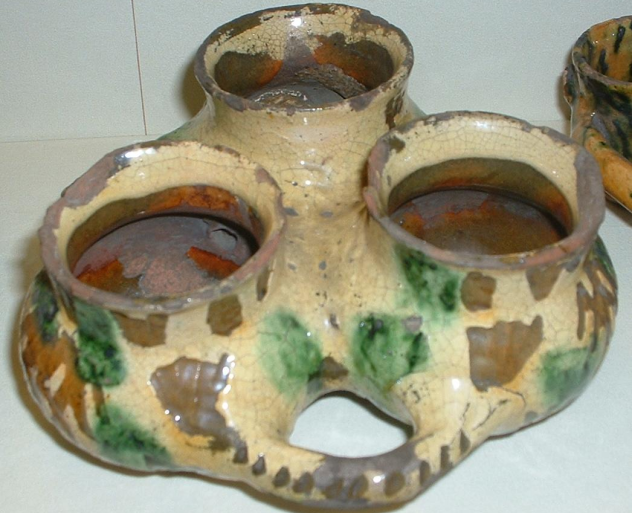
The fuddling cup was more of a puzzle than a game where, just like the wager cup, you had to find a way to drink without spilling any liquid on you. First appearing in 17th-century England, the fuddling cup was made out of three or more cups clustered together and connected through various hidden holes and tubes. In order for someone to drink successfully from the fuddling cup, they would have to use all cups in a specific order so that they wouldn’t spill the contents.
Although simplistic in concept and design, the fuddling cup proved to be popular and paved the way for more complex puzzle vessels, specifically the puzzle jugs. These became a common occurrence in England during the 18th and 19th centuries. Even though puzzle jugs had more intricate designs and decorations, they still relied on the same concept as fuddling cups. A standard puzzle jug would spill if it was used as a regular jug. Instead, the drinker had to find a way to suck up the liquid through holes at the top using a tube hidden in the jug’s handle.
2 Pennying

The origins of pennying are a bit murky, as both Cambridge and Oxford lay claim to its creation, providing yet another thing for the two universities to argue over. At first glance, pennying appears to be a simple concept where all you have to do is sneak a penny into someone’s drink. That person is then obliged to finish the drink in one go in order to “save the drowning queen,” since British pennies have the queen’s face on them.
In spite of its simple premise, pennying comes with a complex set of rules that must be adhered to in order to maintain tradition. For starters, would-be penniers are not allowed to participate unless they also have an alcoholic drink. Double pennying is not permitted, and if it happens, the second pennier must be the one to drink the beer. Alternatively, only one penny may be put in play in order to avoid people double pennying on purpose to get a drink.
There was a time when people didn’t have to consent to playing the game in order to participate. Just by attending Cambridge or Oxford you implicitly agreed to pennying, and if you refused, you encountered the scorn of the student body. That is why pennying has now been outlawed at several colleges at Oxford and Cambridge, since forcing people to drink was ruled a breach of conduct.
1 Passatella

As drinking games progress and people get drunker, the chances of violence increase. In passatella, this was not only expected, but was considered an integral part of the game. The game originated in ancient Rome and remained a popular pastime for Italians over the centuries. It was played with a minimum of four players, although it could accommodate a lot more. The more players involved, the higher the chances of violence.
The concept of passatella was to expose the inequality of life. That is why the first thing to do was to play a game in order to determine a boss and an underboss. Any game could be played as long as it had a winner and a runner-up, but card games or boccie were preferred.
Once there was a boss and an underboss, everybody chipped in to buy a round of drinks. The boss drank his and then offered the underboss a drink. Afterward, the boss offered drinks to all the other players that he wished, but before they could drink, they also had to get permission from the underboss. Both the boss and underboss could deny players the drinks that they paid for. Sometimes, they would also have to say why they denied a player his drink, which was usually done in the form of an expletive-filled rant (that only got more insulting as people got drunker). Naturally, certain players felt cheated, and more than one game of passatella ended in a fight.
Radu is a history/science buff with an interest in all things bizarre and obscure. Share the knowledge on Twitter or check out his website.

